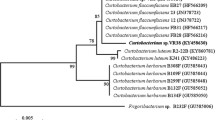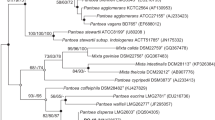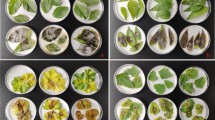Abstract
The host range specificity ofAgrobacterium with five tea cultivars and an unrelated species (Artemisia parviflora) having extreme surface characteristics was evaluated in the present study. The degree ofAgrobacterium infection in the five cultivars of tea was affected by leaf wetness, micro-morphology and surface chemistry. Wettable leaf surfaces of TV1, Upasi-9 andKangra jat showed higher rate (75%) ofAgrobacterium infection compared to Upasi-10 and ST-449, whereas non-wettable leaves ofA. parviflora showed minimum (25%) infection. This indicated that the leaves with glabrous surface having lower 8 (larger surface area covered by water droplet), higher phenol and wax content were more suitable forAgrobacterium infection. Caffeine fraction of tea promotedAgrobacterium infection even in leaves poor in wax (Upasi-10), whereas caffeine-free wax inhibited bothAgrobacterium growth and infection. Thus, study suggests the importance of leaf surface features in influencing theAgrobacterium infection in tea leaf explants. Our study also provides a basis for the screening of a clone/cultivar of a particular species most suitable forAgrobacterium infection the first step inAgrobacterium-mediated genetic transformation.
Similar content being viewed by others
References
Ashby A M, Watson M D, Loake G J and Shaw C H 1988 Tiplasmid specific chemotaxis ofAgrobacterium tumefaciens C58C1 towardsvir inducing phenolic compounds and soluble factors from mono cotyledons and dicotyledonous plants;J. Bacteriol. 170 4181–4187
Barnes J D, Percy K E, Paul N D, Jones P, Mclaughlin C K, Mullineaux P M, Creissen G and Wellburn A R 1996 The influence of UV-B radiation on the physicochemical nature of tobacco (Nicotiana tabaccum L.) leaf surface;J. Exp. Bot. 47 99–109
Biao X, Toru K, Jian X and Yongyan B 1998 Effect of polyphenol compounds in tea transformations;American Society of Plant Physiologists (Plant Biol.) Abstr. No. 314
Brewer C A, Smith W K and Vogelman T C 1991 Functional interaction between leaf trichomes, leaf wettability and the optical properties of water droplets;Plant Cell Environ. 14 955–962
Chandler L D and Thomas C E 1991 Effect of leaf miner feeding activity on the incidence ofAlternaria leaf blight lesions on muskmelon leaves;Plant Disease 75 938–940
Christou P 1996 Transformation technology;Curr. Opinion Biotechnol. 4 135–141
Crisp D J 1963 Water proofing mechanisms in animals and plants; inWater proofing and water repellency (ed.) J L Molliet (Amsterdam: Elsevier) pp 416–481
DeCleene M 1985 The susceptibility of monocotyledons toAgrobacterium tumefaciens;Phytopathology 113 82–89
DeCleene M and DeLey J 1976 The host range of crown gall;Bot. Rev. 42 389–466
Edwards P J 1992 Resistance and defence: the role of secondary plant substances; inPest and pathogens. Plant responses to foliar attack (ed.) P G Ayres (Lancaster: Bioscientific Publisher) pp 69–84
Evans K J, Nyquist W E and Latin R X 1992 A model based on temperature and leaf wetness duration for establishment ofAlternaria leaf blight of muskmelon;Phytopathology 82 890–895
Hamilton C M, Frary A, Lewis C and Tanskley S D 1996 Stable transfer of intact high molecular weight DNA into plant chromosomes;Proc. Natl. Acad. Sci. USA 93 9975–9979
Hawes M C and Pueppke S G 1987 Correlation between binding ofAgrobacterium tumefaciens by root cap cells and susceptibility to crown gall;Plant Cell Rep. 6 287–290
Hawes M C, Robbs S L and Pueppke S G 1989 Use of a root tumorigenesis assay to detect genotypic variation in susceptibility of 34 cultivars ofPisum sativum;Plant Physiol. 90 180–184
Hernandez J B P, Remy S, Sauco V G, Swennen R and Sagi L 1999 Chemotactic movement and attachment ofAgrobacterium tumefaciens to banana cells and tissues;J. Plant Physiol. 155 245–250
Ingelbrecht I, Breyne P, Vancomperonolle A, vanMontagu J M and Depicker A 1991 Transcriptional interferences in transgenic plants;Gene 109 239–242
Jefferson R A 1987 Assaying chimeric genes in plants: The GUS gene fusion system;Plant Mol. Biol. Rep. 5 389–405
Jenks M A, Tuttle H A, Eigenbrode S D and Feldmann K A 1995 Leaf epicuticular waxes of theEceriferum mutants inArabidopsis;Plant Physiol. 108 269–377
Juniper B E and Jefree C E 1983Plant surfaces (London: Edward Arnold)
Karageorgou P, Levizou E and Manetas Y 2002 The influence of drought, shade and availability of mineral nutrients on exudate phenolics ofDittrichia viscose;Flora 197 285–289
Kato M, Mizuno K, Crozier A, Fujimura T and Ashihara H 2000 Caffeine synthase gene from tea leaves.Nature (London) 406 956–957
Kim K S, Taylor S E, Gleason M L and Koehler K J 2002 Model to enhance site specific estimation of leaf wetness duration;Plant Disease 86 179–185
Kumar N 2003Studies on recalcitrance of leaf explants to Agrobacterium mediated genetic transformation during the production of trans genic tea, M.Sc. thesis, Himachal Pradesh Krishi Viswavidyalay, Palampur
Meidner H and Mansfield T A 1968Physiology of stomata (London: McGraw Hill)
Mohamed M Z, Weersinghe D K and Wickremasinghe V 1986 Chemistry of tea (C. sinensis);SriLankan J. Tea Sci. 55 36–43
Mondal T K, Bhattacharya A, Ahuja P S and Chand P K 2001 Transgenic tea (Camellia sinensis (L.) O. Kuntze cv. Kangra Jat) plants obtained byAgrobacterium mediated transformation of somatic embryos;Plant Cell Rep. 20 712–720
Murashige T and Skoog F A 1962 A revised medium for rapid growth and bioassay with tobacco tissue cultures;Physiol. Plant 15 473–497
Nester E W, Gordon M P, Amasino R M and Yanofsky M F 1984 Crown gall: A molecular and physiological analysis;Annu. Rev. Plant Physiol. 35 387–413
Nesme X, Michel M F and Digat B 1987 Population heterogenecity ofAgrobacterium tumefaciens in galls ofPopulus L. from as single nursery;Appl. Environ. Microbiol. 53 655–659
Pandey S and Nagar P K 2002 Leaf surface wetness and morphological characteristics ofValeriana jatamansi grown under open and shade habitats;Biol. Planta. 45 291–294
Pandey S and Nagar P K 2003 Patterns of leaf surface wetness in some important medicinal and aromatic plants of Western Himalaya;Flora 198 349–357
Percy K E, Cape J N, Jagels R and Simpson C J 1994Air pollutants and the leaf cuticle (Berlin: Springer Verlag)
Preece T F and Dickinson C H Preece T F and Dickinson C H 1971 Ecology of leaf surface microorganisms (New York: Academic Press)
Pueppke S G 1984 Plant microbe interactions; inPlant microbe interactions molecular and genetic perspectives (eds) T Kosuge and E W Nester (New York: John Willey) pp 215–216
Reynolds K M, Madden L V, Richard D L and Ellis M A 1989 Splash dispersal ofPhytopthora cactorum from infected strawberry fruit by stimulated canopy drip;Phytopathol. 79 465–469
Sandal I, Kumar A, Bhattacharya A, Ravindranath S D, Gulati A and Ahuja P S 2001A thermolabile caffeine fraction of tea leaves—A substitute of acetosyringone for Agrobacterium mediated genetic transformations (Patent filed in US and PCT)
Sandal I, Bhattacharya A, Kumar S and Ahuja P S 2002 Transgenic Tea (Camellia sinensis L O Kuntze);Xth IAPTC& B Congress. Plant Biotechnology 2002 and Beyond, June 23–28 2002, University of Florida, USA, AbstrNo. 1458
Sandal I 2003Transgenic tea, Ph. D. thesis, Guru Nanak Dev University, Amritsar
Swain T and Hillis W E 1959 The phenolic constituents ofPrunus domesticus I. The quantitative analyses of phenolic constituents;J. Plant Sci. Food Agri. 10 63–68
Szymanski D B, Lloyd A M and Marks M D 2000 Progress in the molecular genetic analysis of trichome initiation and morphogenesis inArabidopsis;Trends Plant Sci. 5 80–84
Willmer C H 1983Stomata (New York: Longman)
Zupan J R and Zambryski P 1995 Transfer of T-DNA fromAgrobacterium to the plant cell;Plant Physiol. 107 1041–1047
Author information
Authors and Affiliations
Corresponding author
Rights and permissions
About this article
Cite this article
Kumar, N., Pandey, S., Bhattacharya, A. et al. Do leaf surface characteristics affectAgrobacterium infection in tea [Camellia sinensis (L.) O Kuntze]?. J Biosci 29, 309–317 (2004). https://doi.org/10.1007/BF02702613
Received:
Accepted:
Issue Date:
DOI: https://doi.org/10.1007/BF02702613




